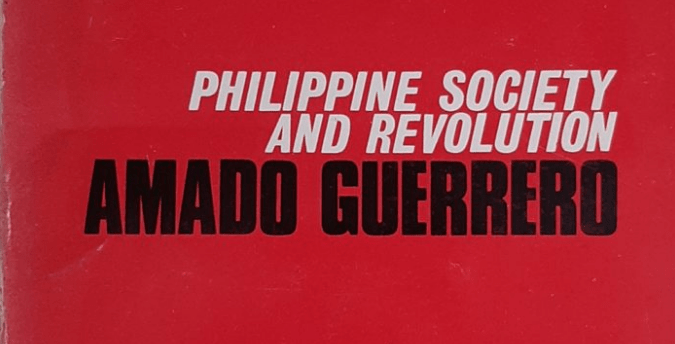This month marks the fiftieth anniversary of the serialized publication of “The Philippine Crisis” in the Philippine Collegian, the prestigious University of the Philippines (UP) Diliman campus newspaper in July 1970. Written by Jose Ma. Sison, founder and head of the Communist Party of the Philippines (CPP), “The Philippine Crisis” was published under the pseudonym Amado Guerrero. By September, two subsequent chapters had been published in serial form in other campus newspapers.
Before the end of the year, the serialized chapters were compiled into a single volume, now entitled Philippine Society and Revolution, and were being circulated in mimeographed form under the imprint “Revolutionary School of Mao Tse-Tung Thought.” In 1971 it was published as a little red book by Pulang Tala Publications. According to Sison, the book was sold “mainly in the lobbies at UP Diliman.” PSR, as it came to be known, has served as the core text of the CPP for the past fifty years.
In his brief introduction to PSR, Sison wrote, “The author offers this book as a starting point for every patriot in the land.” PSR was divided into three parts, in keeping with its initial serialized division: a Review of Philippine history, Basic Problems of the Filipino People, and The People’s Democratic Revolution.
Those interested in a careful reading of PSR with citations and page numbers are encouraged to access my doctoral dissertation, Crisis of Revolutionary Leadership, which is freely available online.
PSR‘s impact on Philippine politics cannot be overstated. It shaped not only the program and perspective of the party itself, but also the language and orientation of emerging mass movements over the course of five decades. In countless incalculable ways it molded the discourse of the humanities and social sciences in the Philippines and gave form and content to art and literature. At times this influence was a conscious one, but it often had a more subtle, diffusive effect. The language of PSR regarding the goal of national democracy and the political tasks which this goal entailed spread widely, in certain periods becoming nearly ubiquitous.
The text was written as a polemic against Jesus Lava and the Partido Komunista ng Pilipinas (PKP), not as an abstract summary of timeless political principles. That a polemic with a political adversary should become the central text of a movement was in keeping with the history of Marxism and Communism, many of the core writings of which originated in an argumentative grappling with a rival thinker over the significance of key historical developments and the programmatic conclusions to be derived from them.
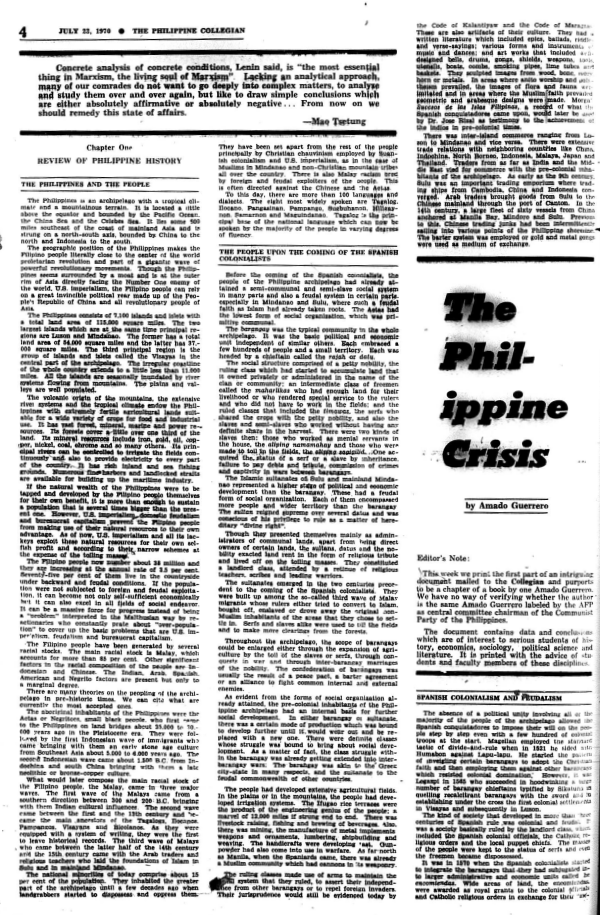
PSR, however, made no effort to situate itself in this Marxist tradition. At no point did it present itself as a development in the history of Marxism; there is not a single line dedicated to the political or theoretical continuity of Marxist thought. Its history and its outlook sharply circumscribed, PSR is, to its core, a nationalist document. This is why Sison inscribed the book to “all patriots” and not to the international working class.
Pause for a moment to reflect on what is not included in this text and you begin to get a sense of just how parochial it is, how unwilling to gaze beyond the archipelago.
PSR, a text dedicated to revolution, makes no mention of the 1789 French Revolution nor does it include a word on 1848 and the revolutions that rocked Europe. What was their class character? What lessons should be derived for future struggles?
It gets worse. Stunningly absent is 1917. Neither February nor October merit even passing mention. PSR is entirely silent on seizure of power by the Russian working class and the role of the Bolshevik party. The CPP, a party that bore the name Communist, had nothing to say about the central event of the twentieth century, the event without which they would not exist. What was the significance of this event for the world’s working class? For the Filipino masses?
Again, what of the 1926-27 Chinese Revolution and its betrayal and crushing by the KMT? These were events of immediate relevance to the political questions confronting workers in countries of belated capitalist development around the globe. PSR was silent.
Scan the pages of PSR and try to find mention of the Communist Manifesto. It is absent. So too is Capital. Marx himself is absent, except as a header in the phrase “Marxism-Leninism-Mao Zedong Thought.” Engels, Plekhanov, Luxemburg, Trotsky, Kautsky — it is as if they never existed. PSR apparently regarded their disputes and ideas as irrelevant to the struggles of the Filipino masses.
The history of Marxism is not the only glaring lacuna. This work was written in 1970 yet the critical problems and revolutionary struggles gripping the globe were similarly treated as irrelevant. The Partai Komunis Indonesia (PKI) was slaughtered in 1965-66, but neither the PKI nor its massacre merited mention. Suharto, now ruling as dictator in Indonesia, was similarly absent. An analysis of his rise was critical to an understanding of the trajectory of Marcos, but PSR had nothing to say on this point.
Ho Chi Minh, the Vietminh, the Vietcong — the Vietnam war was the foremost political crisis in the world, but PSR was silent.
Lin Biao, Zhou Enlai, Liu Shaoqi — while the text heralded “Mao Zedong Thought,” it made no examination of the crisis gripping the Chinese Communist Party. PSR was silent.
The Cuban revolution was mentioned once, but here the parochialism of PSR is even more striking, for it was mentioned only for the impact which it had on Philippine sugar production. Its class character, its outcome, the attitude which Filipino workers should take towards it? PSR was silent.
These glaring silences did not express a want of space but rather a lack of interest. When it appeared in 1971, PSR was nearly three hundred pages long and it dedicated paragraphs to what “racial stocks” made up the “Filipino people,” but none to the history or theoretical heritage of Marxism, and none to the broader world.
If PSR was concerned with neither the history of Marxism nor of global developments, what was its core conception?
Sison and a group of co-thinkers were expelled from the Partido Komunista ng Pilipinas (PKP) in April 1967. In early 1969 the expelled cohort founded the Communist Party of the Philippines (CPP). The PKP and the CPP shared a political program, the program of Stalinism, but they were divided sharply over how to acheive its ends.
Stalinism was the programmatic expression of the political interests of privileged layers of the ruling party bureaucracies in Moscow and Beijing. Seeking to defend and expand the social basis of their positions, the bureaucrats put forward the nationalist perspective of building socialism in one country as the paramount political task. World socialist revolution was subordinate to this end.
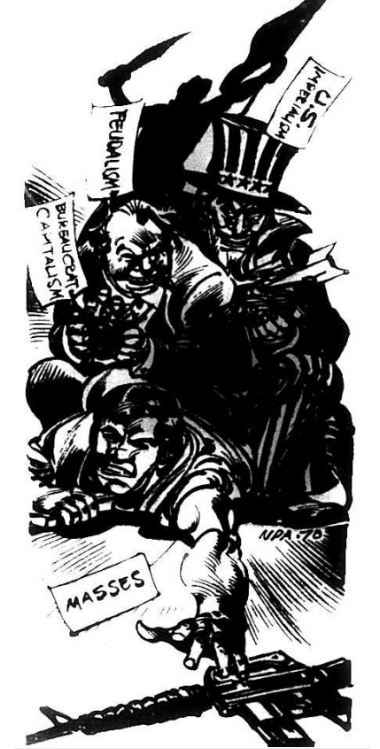
Looking to secure diplomatic and trade relations in service to the construction of the national economy, the Stalinist bureaucracies sought political capital with which to negotiate with the ruling class in countries around the world. To this end they rehabilitated the old Menshevik line of a two-stage revolution. They instructed Communist parties around the globe that the tasks of the revolution in which they were engaged were not yet socialist in character but national and democratic only. A section of the capitalist class, they claimed, would play a progressive role in this necessary first stage. The function of the Communist party leadership was thus to secure an alliance with this progressive section of the so-called ‘national bourgeoisie,’ and to bring the pressure and support of a mass movement behind it. In this way, the Stalinist bureaucracies could bargain with the ruling elite around the globe, calling off strikes and supplying mass electoral support in exchange for favorable diplomacy and trade deals.
Many of the leading political operatives at the helm of Communist parties were drawn to the program of Stalinism because it was seen as a means of implementing nationalist reforms. Sison and Lava shared this enthusiasm. It allowed them to deploy the banner of Marxism and use it to win mass support for the industrialization of the economy under native capitalist ownership, in opposition to the control of major foreign corporations. Loans from and trade with the Soviet bloc were seen as an additional measure in furtherance of this end. When he was still a leading member of the PKP, Sison had organized mass support for Ferdinand Marcos on this basis and endorsed his election in 1965.
Moscow and Beijing, both committed to the construction of socialism within their own borders, never merged their economies. Their divergent national interests inevitably conflicted, giving rise to rivalry, then open split and armed conflict. The uneven economic development of the two countries and their starkly different geopolitical circumstances fueled the tensions between them. Situated behind the buffer zone of Eastern Europe and resting on a fairly stable industrial base, Moscow articulated a policy of ‘peaceful coexistence’ with Washington and established friendly ties with autocrats.
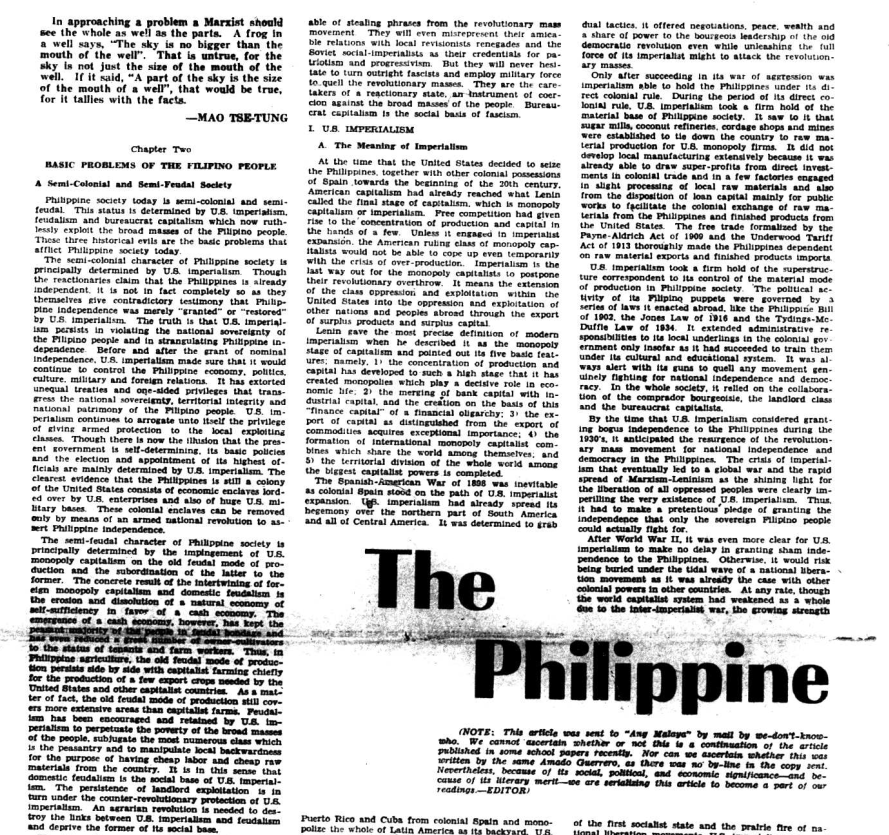
Beijing, in contrast, found itself in the mid-1960s threatened on all sides, facing the imminent threat posed by the US invasion of Vietnam and the loss of its largest international ally, the Partai Komunis Indonesia (PKI), which was slaughtered in Suharto’s seizure of power in 1965-66. The Chinese Communist Party (CCP) sought to whip up armed struggle throughout the region to diffuse the threat of US imperialism from China’s immense imperiled borders. While Moscow embraced the Shah, Lin Biao articulated the line of protracted people’s war, armed uprisings throughout the ‘countryside of the world’ backed by China, the ‘Yan’an of world revolution.’
By the end of the decade the ideas of Lin Biao had combined in the popular imagination of a generation of youth with images of Mao’s Little Red Book and cultural revolution, and the amalgam was seen as the embodiment of true revolutionary politics, in opposition to the conservative bureaucratism of Brezhnev. Parties split along these lines. The breakaway leaderships did not oppose the Stalinist perspective of an alliance with a section of the capitalist class, but they sought to secure this alliance not with loans from Moscow but with the radical cachet of the political line of Beijing, which gave them a grip on the imagination of the burgeoning protest movement.
This then was Sison’s concern: to use the strategy of protracted people’s war to secure hold over the growing social unrest of the time and then to use this mass base to form an alliance with a section of the capitalist class. From 1970-72, the CPP and its front organizations, for all their talk of protracted people’s war, were in an intimate alliance with the elite opposition to Marcos, which was organized in the Liberal Party. The CPP allied with the sugar barons and their political representatives; the PKP, meanwhile, allied with Marcos.
PSR thus needed to establish that the failures of the PKP in the past were the result of its leadership, the Lavas, and not of its program, Stalinism. PSR sought to demonstrate that Stalinism was in fact correct: the conditions in the Philippines precluded any struggle for socialism at present, a section of the capitalist class was necessarily progressive, and it was the task of workers and peasants to ally with and support it.
In the first week of July, Joma Sison wrote an open letter, which he signed with his actual name and sent to Vicente Clemente, secretary general of the Movement for a Democratic Philippines. Clemente had the letter published in a number of newspapers, including the Collegian. In his letter, Sison declared
The more the Marcos fascist clique resorts to the use of the army, police, courts and prisons to oppress the people the more shall it bring infamy unto itself and spell clearer the utter bankruptcy of the present reactionary state that is the puppet of US imperialism and class instrument of the compradors and landlords. The Marcos fascist clique has emerged as an unmitigated enemy of Filipino independence and democracy….
But fascism will only cast more fuel to the flames of the revolutionary mass movement.
I call upon the people of every patriotic class and group to close ranks and oppose the campaign of fascist terror being waged by the Marcos puppet clique. I believe the people will never waver in fighting for and depending [sic] their own sovereignty and democratic rights.
Sison was repeating a rhetorical staple of the CPP: fascism aided the growth of revolution for “repression breeds resistance.” He stated that “I shall soon issue another book which I have been researching on and writing since last year.” This was a remarkable slip on Sison’s part, for the book which he was about to publish was Philippine Society and Revolution, which appeared under the name Amado Guerrero. Sison, at the time, vehemently denied that he was Guerrero, and the CPP denounced anyone who made the identification.
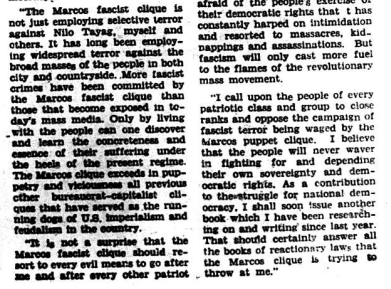
PSR, as it rapidly came to be known, was first published in installments in college newspapers beginning in late July 1970. At the time of its serialized publication the work was entitled “The Philippine Crisis”. The first chapter was published as “Review of Philippine History” in the Collegian; the second chapter was published as “Basic Problems of the Filipino People” in Ang Malaya, the student paper of the PCC; and the third in Guidon at Ateneo. Each chapter was serialized in installments across multiple issues of the student paper, and thus each week a new chunk of Sison’s work appeared on campus.
In the July 23 issue, which published the first installment of “The Philippine Crisis”, Popoy Valencia, member of the Samahang Demokratiko ng Kabataan (SDK) and editor of the Collegian, included an editorial statement: “This week we print the first part of an intriguing document mailed to the Collegian and purports [sic] to be a chapter of a book by one Amado Guerrero. We have no way of verifying whether the author is the same Amado Guerrero labeled by the AFP [Armed Forces of the Philippines] as central committee chairman of the Communist Party of the Philippines.”
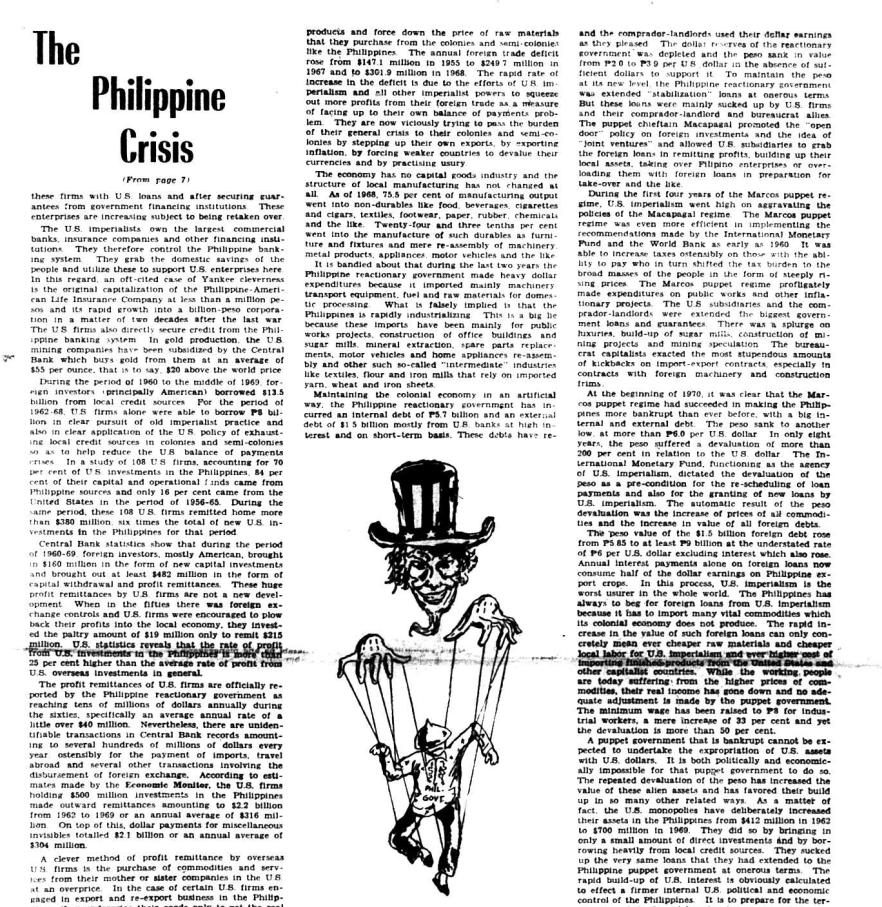
The second chapter appeared in the September 21 and subsequent issues of Ang Malaya. The editor — Jaime FlorCruz — included a note, “This article was sent to Ang Malaya by mail by we-don’t-know-who. We cannot ascertain whether or not this is a continuation of the article published in some school papers recently. Nor can we ascertain whether this was written by the same Amado Guerrero as there was no by-line in the copy sent. Nevertheless because of its social, political, and economic significance — and because of its literary merit — we are serializing this article to become a part of our readings.”
The structure of PSR followed a pattern established by Mao Zedong. Writing in Yan’an in the winter of 1939, Mao published a work entitled The Chinese Revolution and the Chinese Communist Party, which was divided into two chapters — “Chinese Society” and “The Chinese Revolution.” In the first chapter, Mao established that imperialism had made China a semi-feudal, semi-colonial country, in which “[t]he contradiction between imperialism and the Chinese nation and the contradiction between feudalism and the great masses of the people are the basic contradictions in modern Chinese society.” On this basis, Mao argued in the second chapter that “[u]nquestionably, the main tasks are to strike at these two enemies, to carry out a national revolution to overthrow foreign imperialist oppression and a democratic revolution to overthrow feudal landlord oppression.” Mao then analyzed each of the classes in Chinese society — landlords, bourgeoisie, petty bourgeoisie, peasantry, and proletariat, drawing a sharp distinction between the “comprador big bourgeoisie” and the “national bourgeoisie,” for the latter “can become a revolutionary force.” Mao concluded that the Chinese revolution was a “two-fold task” — “[t]o complete China’s bourgeois-democratic revolution (the new-democratic revolution) and to transform it into a socialist revolution when all the necessary conditions are ripe.”
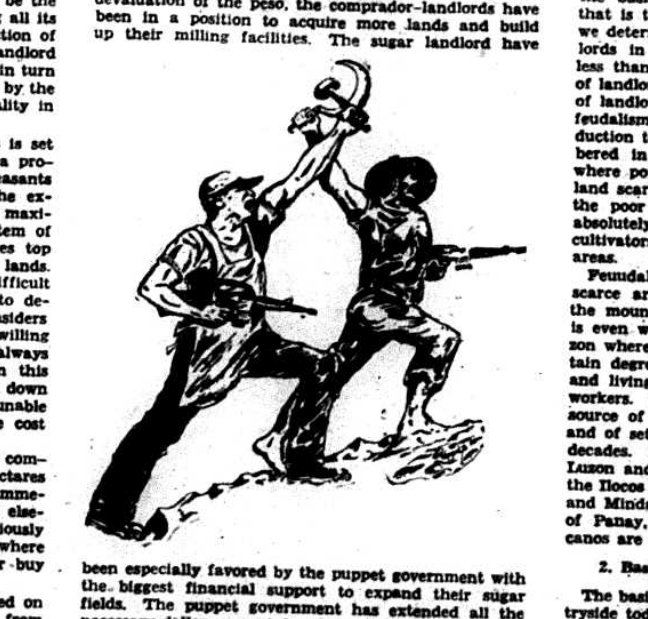
Modeling himself on Mao, D.N. Aidit, head of the Partai Komunis Indonesia (PKI), published a similar work in 1957, “Indonesian Society and the Indonesian Revolution.” The work was divided into two chapters. The first chapter on Indonesian Society, established that because of imperialism, Indonesia was a semi-feudal, semi-colonial country. Aidit expanded upon Mao’s opening chapter, incorporating historical material to justify the party’s relationship with Sukarno and to blame Vice President Hatta for the country’s political ills, including the violent suppression of the PKI at Madiun in 1948. Like Mao, Aidit concluded that the tasks of the Indonesian revolution were national and democratic in character and not yet socialist, and like Mao, he examined each of the classes in Indonesian society and drew a distinction between the comprador and national bourgeoisie.
By the time, Sison wrote PSR the Maoist crib sheet for writing the programmatic text for the movement was already well-worn. He followed Aidit’s innovation of including polemical historical material in the first chapter and reached the same conclusions as his predecessors: the Philippines was semi-colonial and semi-feudal and, as a result, the tasks of the revolution were not socialist and the national bourgeoisie should be treated as an ally.
I feel compelled to include an aside at this point. Because Sison modelled his work on Mao and Aidit, and drew inspiration from them, he has been accused on several occasions by reactionary figures in the press and academia of plagiarizing PSR. The accusation is absurd. It is a charge that is employed by those who will not, or perhaps cannot, engage in a coherent criticism of Sison’s ideas and so they grasp for whatever mud they can find to throw at him.

